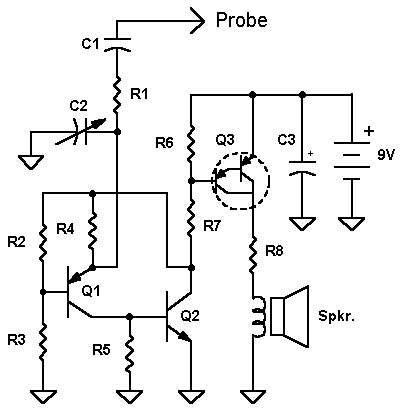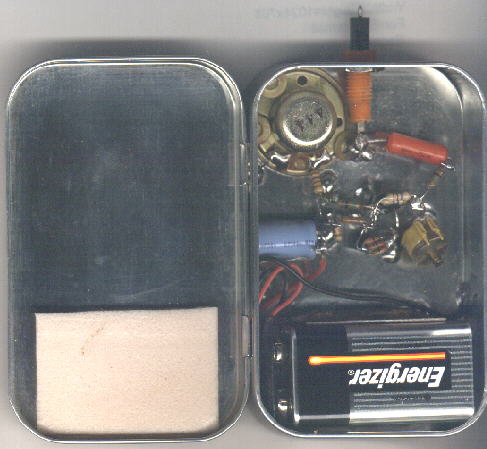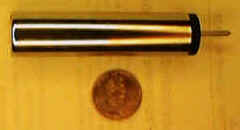The Curious C-Beeper uses the two-transistor flasher in conjunction with a darlington transistor to make a most unusual capacitance beeper probe. When a capacitor is touched to the probe, the probe beeps at a frequency that varies with capacitance. The frequency change is so steep with capacitance that tiny capacitors may be precisely matched or an exact fixed value may be selected to replace a trimmer in a prototype. If the user has reasonably moist skin, simply holding one lead of the capacitor to be tested while touching the other lead to the probe is all that is necessary. The user's body forms the other connection through the beeper's metal case. When the beeper is properly adjusted it draws only 10 uA with nothing touching the probe - no power switch is required. This design is optimized for capacitors less than about 0.1 uF (100 nF). Large capacitors give a low frequency "clicking" sound and small capacitors sound a tone that increases as the capacitance decreases. Many decades of frequency change occur over the beeper's range giving even the more tone-deaf among us sufficient change to discern slight differences in capacitance.
| Part | Description |
| R1 | 1 megohm |
| R2 | 7.3 megohm (use 3, 22megohms in parallel) |
| R3 | 22 megohm |
| R4 | 5 megohm (use 2, 10 megohms in parallel) |
| R5 | 1.5 megohm (use a 1 meg. in series with 470k) |
| R6 | 39 k |
| R7 | 33 k |
| R8 | 100 ohm |
| C1 | 0.047 uF (not critical) |
| C2 | 30 pF (or more) trimmer |
| C3 | 100 uF, 10 volt or more |
| Q1 | 2N4403 (substitution risky) |
| Q2 | MPS-A18 (substitution probably won't work) |
| Q3 | MPS-A56 (sub may work - use darlington) |
| Speaker | 1.1" mylar (8 ohm) or similar speaker |
| Battery Clip | standard battery snap |
| Battery | 9 volt rectangular - Alkaline recommended |
| Probe | pin jack or similar with short wire probe |
| Case | Altoids mint tin or similar metal box |

The probe should be built into a metal box so that one hand makes good contact to the circuit ground. My beeper is built into an Altoids Mint box with the paint sanded off (use steel wool). Leave the paint if you like the artwork! I prefer the scientific motif. The open beeper is shown below. The thin metal box is easily soldered so all ground connections are directly soldered to the box. Also note the strip of PCB material soldered into place next to the battery to form a simple battery holder. A strip of foam pushes on the battery when the lid is closed. There is a single small hole for the sound under the speaker.

Below is a fancy version built into a round nickel-plated can using a miniature 7.5 volt battery and a small electro-magnetic transducer from an old processor card (the "beeper" speaker). The left end of the probe has a small hole for the sound and the probe end has a tight-fitting grommet with a probe tip in the center hole. A ground connection is made internally.

Parts substitution is risky! The resistor values are selected to barely turn on the transistors to conserve battery power. The transistors must have very high gain and good low current properties. The MPS-A18 is a very high gain transistor with excellent gain at very low currents and substitutions may not work well. The capacitors are not particularly critical but the trimmer might require a little care. The trimmer is adjusted until the beeping just stops and only a very weak squeal is heard when a 2.2 pF capacitor is touched to the probe. Attempting more sensitivity risks excessive battery current. Less sensitivity is fine if the probe is not to be used on very low values.
Applications
The Curious C-Beeper will become indispensable in virtually no time!
- Quickly match capacitors and trimmers. Forget the capacitance meter when matching parts from the parts bin or selecting a fixed value to replace a trimmer - the "fingers as conductors" feature makes the C-Beeper super-fast when searching for that perfect value.
- Easily detect tiny variations when a capacitor is heated or cooled to quickly discriminate between NPOs and "Stable" dielectrics. General purpose and temperature compensating dielectric are quite easy to spot.
- The C-Beeper makes an excellent cable fault locator - the end with the open will have less capacitance and beep at a much higher pitch or not at all. A break along an unshielded bundle can be spotted by grabbing the bundle at various points while listening for the capacitance change.
- Identify which wire is which at the end of a bundle without stripping back the insulation. Touch the bare wire at one end with the C-beeper probe and pinch the still-insulated wires at the opposite end. The right wire will drop the pitch.
- Identify traces on unpopulated PCBs right through solder mask - touch the C-beeper to the exposed end of the trace and use a finger to follow the trace across the board.
- Check the value of feedthrough capacitors after they are installed - a difficult operation with a capacitance meter.
- Identify varicap diodes. They beep at a much lower pitch than regular diodes.
- Make a small flat plate electrode and line voltage electric fields may be detected. Follow wires behind walls and ceilings or determine if wires are "hot" without touching them. The C-Beeper's tone is modulated by the AC voltage causing a warbling sound. Circuits with lamp dimmers, solid-state switches or fluorescent bulbs are especially easy to detect due to the harmonics on the line.